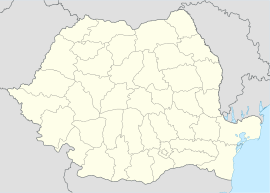Câmpulung Moldovenesc facts for kids
Quick facts for kids
Câmpulung Moldovenesc
|
||
|---|---|---|

View of the town from Obcina Feredeului
|
||
|
||

Location in Suceava County
|
||
| Country | ||
| County | Suceava | |
| Area | 147 km2 (57 sq mi) | |
| Elevation | 600 m (2,000 ft) | |
| Population
(2011)
|
Lua error in Module:Wd at line 1,575: attempt to index field 'wikibase' (a nil value). | |
| Time zone | EET/EEST (UTC+2/+3) | |
| Postal code |
725100
|
|
| Area code | (+40) 02 30 | |
Câmpulung Moldovenesc is a city in Suceava County, located in northeastern Romania. It is found in the historical area known as Bukovina.
This city is the fourth largest urban area in its county. About 15,642 people lived here, according to the 2021 census. Câmpulung Moldovenesc became a special type of city called a "municipality" in 1995. It covers an area of 147 square kilometers.
Contents
What's in a Name?
The name "Câmpulung" means "Long Field" in Romanian. The word "Moldovenesc" means "Moldavian." This helps people tell it apart from another city named Câmpulung Muscel.
The city has different names in other languages. In Hungarian, it's Moldovahosszúmező. In German, it's Kimpolung or Kimpulung. Ukrainian speakers might call it Kimpulung Moldovanesk or Dovhopillja. In Polish, it's Kimpulung Mołdawski.
Where is Câmpulung Moldovenesc?
Câmpulung Moldovenesc is in the Bukovina region of northeastern Romania. It sits in a mountain area called Obcinele Bucovinei. The city is built along the banks of the Moldova River.
You can reach the city by car or train. A main road, European route E58, goes through the city. This road connects the Moldavia region with Transylvania. There are two train stations in the city. One is in the city center, and the other is in the Capu Satului neighborhood.
There are many interesting places to visit nearby. You can see the Rarău peak and the Giumalău peak. These are the highest mountains in the region, at 1650 meters and 1857 meters tall. You can also explore the beautiful forests around Câmpulung Moldovenesc. Many people enjoy visiting the old monasteries in the nearby villages.
A Look at History
The first time Câmpulung Moldovenesc was mentioned in writing was on April 14, 1411. At that time, Alexandru cel Bun was the ruler of Moldavia. A famous writer, Dimitrie Cantemir, wrote about a special area called Ocolul Câmpulung. This area had its own rules and leaders. It included 15 villages.
In the past, Câmpulung Moldovenesc followed a special set of laws called the Magdeburg rights. These laws helped towns manage themselves. They were common in medieval towns like Suceava.
From 1775 to 1918, Câmpulung Moldovenesc was part of the Habsburg monarchy. This was a large empire that later became Austria-Hungary. After World War I, the town became part of the Kingdom of Romania.
Between 1925 and 1950, Câmpulung Moldovenesc was the capital of Câmpulung County. This was the largest county in the Bukovina region. Later, the city became part of Suceava County in 1968.
Culture and Museums
Câmpulung Moldovenesc has a unique place called the Wooden Spoons Museum. This museum shows a large collection of wooden spoons. They were collected by a history teacher named Ion Țugui.
How Many People Live Here?
| Historical population | ||
|---|---|---|
| Year | Pop. | ±% |
| 1910 | 8,784 | — |
| 1930 | 10,071 | +14.7% |
| 1948 | 11,041 | +9.6% |
| 1956 | 13,627 | +23.4% |
| 1966 | 15,031 | +10.3% |
| 1977 | 18,648 | +24.1% |
| 1992 | 22,143 | +18.7% |
| 2002 | 20,041 | −9.5% |
| 2011 | 16,105 | −19.6% |
| 2021 | 15,642 | −2.9% |
| Source: Austrian and Romanian census data and/or official estimates | ||
The population of Câmpulung Moldovenesc was highest in 1992. More than 22,000 people lived there then. In 2016, it was the fourth largest urban area in Suceava County. The biggest cities were Suceava, Rădăuți, and Fălticeni.
At the 2011 census, most people living in Câmpulung Moldovenesc were Romanians. There were also small groups of Germans, Roma, Ukrainians, and Hungarians. In the 2021 census, the city had 15,642 people.
What Does the City Make?
The main industries in Câmpulung Moldovenesc are making dairy products and working with lumber. Many people also work in ecotourism, which means tourism that helps protect nature. Some people in the city also work in farming and raising cattle.
Famous People from Câmpulung Moldovenesc
- Maria Diaconescu (born 1937), a javelin thrower.
- Vasile Gheorghiu (1872–1959), a professor of theology.
- Marian Kielec (born 1942), a Polish football player.
- Leibu Levin (1914–1983), a storyteller, singer, and composer.
- Anca Parghel (1957–2008), a jazz singer and musician.
- Daniel Popescu (born 1981), a politician.
- Ion Ștefureac (1871–1920), a professor and architect.
Gallery
See also
 In Spanish: Câmpulung Moldovenesc para niños
In Spanish: Câmpulung Moldovenesc para niños
















